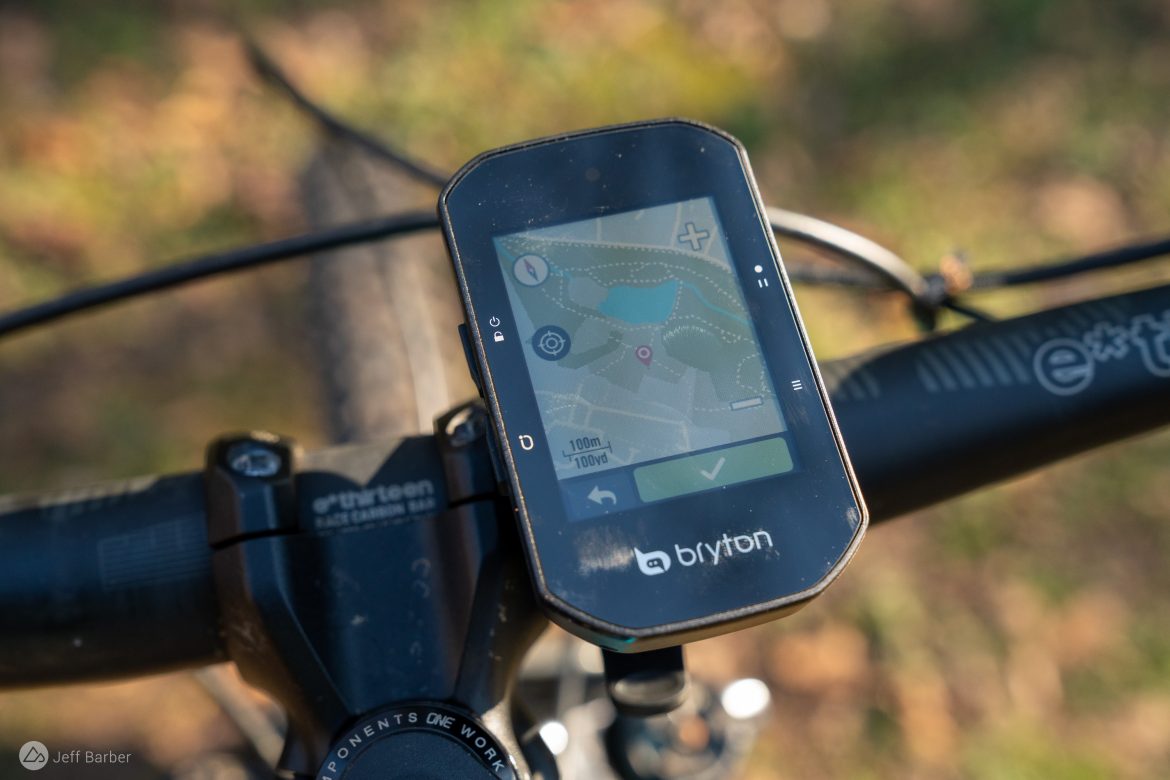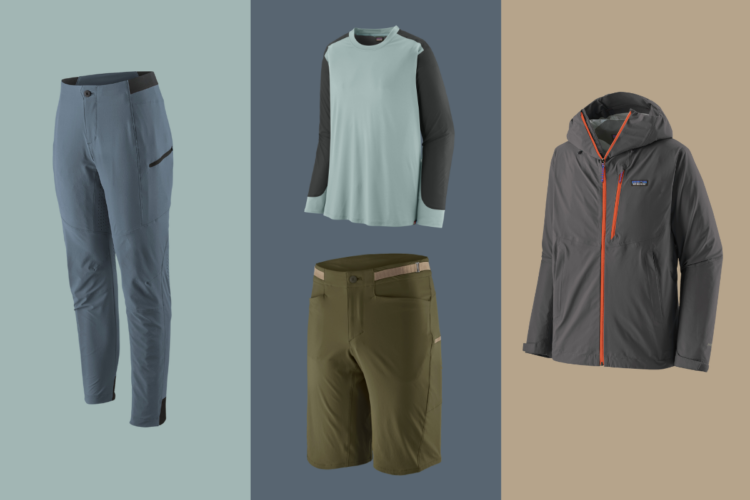
Bryton recently cranked out the first device in a new “S” series of premium GPS units, dubbed the Rider S500. While the unit adds a few MTB-focused features not included in their previous color-screen models, many of the upgrades seem to be geared toward playing nice with other devices like indoor smart trainers and radar units for road biking.
Physical specs
The Bryton Rider S500 is a mid-size GPS unit with a 240x320px color screen (2.4″ diagonal) that weighs 87.3g. The bezel around the top and bottom of the screen is especially large compared to other units I’ve tested like the Garmin Edge 530, resulting in a noticeably smaller screen size despite similar resolution and overall unit dimensions. Bryton seems to be using some of that extra space for a bigger — or at least longer-lasting — battery than some of their previous models, claiming 24 hours of runtime for the S500. That claim seems about right based on my testing; I clocked about 12 hours of ride time over three rides on a single charge, with 49% battery life to spare.

The Rider S500 needs just four physical buttons — two on each side — to operate the device which helps flatten the learning curve a bit compared to others with more buttons. Navigating menus and functions is relatively painless, though, for certain tasks like customizing data screens, the free Bryton smartphone companion app is invaluable.
In addition to the buttons, the device also features a touch screen that’s surprisingly responsive. Previous units from Bryton felt laggy, and almost every other cycling GPS screen I’ve tried hasn’t been great at registering touch inputs, especially compared to smartphone screens. Swiping between data screens is no problem even when wearing gloves, though naked fingers work best for really delicate operations like panning and zooming the map.
One of the main feature upgrades the S500 brings to the Bryton line is an ambient light sensor that adjusts the screen’s brightness. I found it works pretty well and ensures the screen is readable in full sun and on night rides alike. Even subtle changes like a passing cloud or transitioning from shady singletrack to an open area adjusts the backlight and brightness.
The device is charged using a standard USB-C connector.

Mounts
I’m about to go on a mini-rant about GPS mounts so bear with me here. Really, this applies to anything in the cycling world that’s bar-mounted from GPS units to cameras and lights.
Can we all please just use the same mounts?
I get it, no one wants to invent a thing that all their competitors latch onto and copy, and the licensing fees are likely pretty sweet for the inventor. Garmin seems to have invented the quarter-turn mount system, then Wahoo rotated the thing 90° for some unknown reason (though I have a guess). Later Bryton came along and kept the same orientation as the Garmin mount, but made the locking tabs fatter so there’s no swapping between the two.
You and I, the consumers, are caught in the middle of all of this nonsense and end up with a drawer full of mounts every time we upgrade to a competitor’s GPS. End rant.
Fortunately, all is not lost because Bryton now includes a Garmin-compatible mount in the S500 box, along with a tiny screwdriver for making the swap.
Trail features
The Bryton Rider S500 does all the usual stuff, tracking speed, distance, elevation, grade, and the like. Pre-loaded basemaps include not just roads but also trails and now, markers for points of interest like bike shops, water fountains, etc.
Easily the most disappointing thing about the Bryton Rider S500 is the fact that the digital breadcrumb display showing where you’ve already ridden is really, really hard to see. I rely on this standard cycling GPS feature heavily, and an informal poll among riding friends reveals they do as well. It’s as if the Bryton designers have only ever used GPS in a car where no one really needs a breadcrumb. The difference, as riders know, is that most bike rides start and end in the same place, and mountain bike rides in particular often involve a lariat, or figure 8, or some other configuration where the rider ends up somewhere they’ve already been. Or, as is occasionally the case, mountain bikers get lost and need to backtrack, or find a shortcut. On the Bryton Rider S500, the line showing where you’ve been is one pixel wide and is a blue-ish green color that’s nearly impossible to see. In fact I didn’t even realize it was there until after my first few rides. Unfortunately I couldn’t find a way to change the color or thickness of the line.
If you do want to retrace your route back to the start you can swipe up on the map screen, choose ‘Courses,’ then ‘Route,’ then ‘Retrace Route.’ Navigating a retrace shows a bold, thick line that’s much easier to identify.

There are a number of options for navigation with the Rider S500, though some of the more complex use cases like automatic reroutes and voice navigation require a connected smartphone that is in turn connected to the internet. There’s a new Live Track feature as well which is a nice safety feature for solo forest rides, though it too requires a smartphone connection.
It’s possible to grab routes and GPX data from third party services like Strava, or by emailing a file to your phone and opening it in the Bryton app. Navigating saved routes is possible using the GPS alone which is what most mountain bikers will want to do.
Bryton made the Rider S500 compatible with countless devices, including their own heart rate and wheel-based speed sensors. I was even pleasantly surprised to find that my Garmin GPS watch can share its heart rate data with the S500 flawlessly. That’s proof, I suppose, that it is possible for everyone to get along after all.
One cool feature (or possibly just a failsafe measure) is the S500’s ability to resume tracking after the device has been turned off. Often a dead GPS means a lost ride file at worst, or an incomplete one at best. During testing I had the S500 set to turn itself off after a period of inactivity, which usually coincided with post-ride drinks at the local pizza joint. Pitchers drained, I was able to turn the power back on and resume the ride as if nothing happened.
By pairing the Bryton Rider S500 to your smartphone and the Bryton app you can get text and call notifications on the unit, though understandably there’s no way to respond directly. The Bryton app stores details about your rides, and the interface is pretty basic compared to others like Strava or even the Garmin app. Curiously, I couldn’t find a way to share any of my rides via the Bryton app. I ultimately plugged the unit into my computer and grabbed the .fit file I needed. While the app should keep a record of every ride, the device is only able to store data from the most recent rides, or about 300 hours of ride time according to the spec sheet.
Accuracy
I didn’t conduct a full-on track test with the Bryton Rider S500 so I can’t speak in depth about its accuracy. The GPS helpfully has a setting to adjust the polling frequency between once every four seconds, or once per second. I tested on the once per second setting for maximum accuracy and detail.
On an incredibly tight and twisty trail that’s known to be almost exactly two miles long, the Rider S500 reported a distance of 1.44 miles. To put that in perspective, I’ve had GPS units record anywhere from 1.0 miles to 1.7 miles for this trail so that’s not a bad result.
Bottom line
The Bryton Rider S500 raises the bar for the brand, though sadly the experience falls a bit short for me due to the hard-to-see, in-ride breadcrumbs. That’s a shame too, given how well the GPS works with other devices and how responsive the touchscreen is, even when wearing gloves. Priced at $299 (available at Amazon) the Rider S500 costs the same as the similarly fully-featured (though not touch screen) Garmin Edge 530.
⭐️ The Bryton Rider S500 is available for purchase at Amazon.
Party laps
- Touchscreen works well
- Ambient light sensor
- Long battery life
Pros and cons of the Bryton Rider S500.
Dirt naps
- Breadcrumbs are very difficult to see
- Smartphone connection needed for advanced features
- App interface is basic and lacks features like route sharing










0 Comments